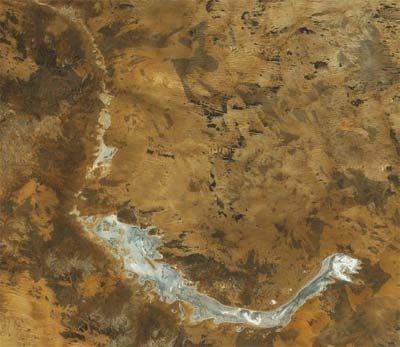Dragon hunting above, dragon hunting below

On May 23 -- the day after the SpaceX Dragon capsule launch -- International Space Station astronaut André Kuipers snapped this shot of the Earth:
[Click to ensmaugenate.]
André -- who's Dutch -- put this up with the caption "Er zit een draak achter ons aan!" -- "There's a dragon after us!". That's a funny pun, given the name of the capsule that was already on its way there.
But he didn't say what this feature was! I wanted to find out, and wound up with a fun story.
Because I was curious, I first read the comments on the Flickr page for this picture. Flickr use PC101 said it was Lake Puarun in Peru seen at an oblique angle. I looked on Google maps, and there's a decent resemblance. But it didn't sit right with me. I couldn't get enough landmarks to match up between the two photos, so I investigated a bit more.
Looking at the picture header, it says the photo was taken at 05:58 UTC on May 23, 2012. Wolfram Alpha shows that's when ISS was over Australia, way too far around the Earth to see Peru. And the landscape around the lake is red, as you might expect from western Australia...
So I went back to Google maps, looked over Australia, and within about a minute found a suspicious-looking dry lake bed called Lake Rason. I zoomed in, and, well, here be dragon!
[Click to komodenate.]
I rotated this screenshot to more or less match the orientation of the one from the ISS, and clearly this is it. Funny, too: the "tail" is even longer than in the ISS picture, making it look even more like a serpent!
Now think about that. All I had to go on was a picture taken on board the space station and the time it was taken. I didn't know what direction André took the shot, what magnification he used, or anything like that. All I had was the time he took the picture, and access to the internet... and a bit of experience knowing where to go to get more information.
And within a minute I had my answer! I could see plainly where and what this was. Interestingly, if the timing in the header is accurate and it was exactly 05:58 UTC, then the ISS was nearly directly over the lake when this picture was taken! You can see that for yourself: click here to see the map of the area where I've added an arrow to mark the position of the ISS at the time. The lake is in the middle, and looks upside-down.
Keep in mind, the ISS is screaming around the planet at 8 km/sec, so being off by a minute can mean a different of 500 kilometers. Incredible.
So there you go. Seek and ye shall find! And nicely, the Dragon spacecraft found the ISS just a day later, and made history. André has lots of pictures of that as well, which you can find on his Flickr page. Go check 'em out... and if you find something you don't understand, why, now you know what to do.
Image credit: ESA/NASA; Google Maps
Related Posts:
- A puzzling planet picture from the ISS
- Followup: City lights from space
- A dragon fight in the heart of Orion
- Deflated Supermoon
- Space Station star trails






























